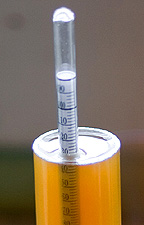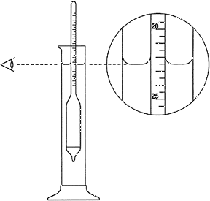One of the wine making products we offer that seems to overwhelm so many beginning wine makers is the gravity hydrometer. But it’s not necessarily the actual using of the gravity hydrometer that seems to be so confounding. Just its looks alone seem to have the ability to put a beginning winemaker into a blank stare.
And it’s understandable. When you first look at a gravity hydrometer, basically what you are seeing is a scientific instrument. That can be intimidating in of itself. It has a funny shape with all kinds of measuring scales and other markings to be read along its side, and inside there’s a blob of stuff that you have no idea what it is or what it’s does.
Well, if there’s such a thing as looks being deceiving, this is certainly a prime example. The hydrometer doesn’t really do anything except float. It has nothing inside that goes up or down like a thermometer. It doesn’t change color like a prism. It just floats.

Your only job is to see how high or how low it is floating. You do this by looking where the surface of the liquid crosses the scales. What this information does is tell you how much sugar is in the liquid. The higher the gravity hydrometer floats the more sugar you have.
During a fermentation sugar turns into alcohol, so if you know how much sugar you have, you’ll know how much alcohol it can make. The hydrometer is also useful for checking the progress of a fermentation and for telling you if your fermentation is complete.
We have a couple of articles listed on our website that will give you more details about the hydrometer and how it is used in wine making, “Getting To Know Your Hydrometer” and “Hydrometer Scales And What They Mean.” Both articles with take the intimidation right out of you.
———————————————————————————————————
Ed Kraus is a 3rd generation home brewer/winemaker and has been an owner of E. C. Kraus since 1999. He has been helping individuals make better wine and beer for over 25 years.
